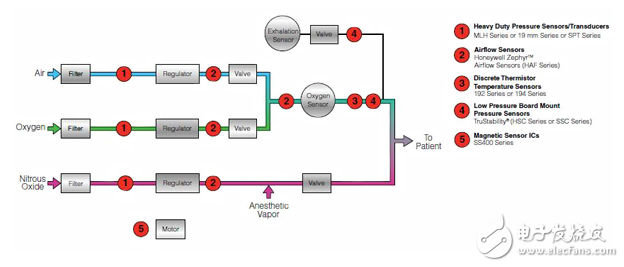
资料下载

医疗器械用传感器,第1部分:气体监测、混合和输送系统
医疗器械用传感器,第1部分:气体监测、混合和输送系统
这似乎两种方法。我们花费了大量的时间和精力监控机器,现在越来越多的机器也在监视我们。这里的主题不是监视或安全,而是医疗器械,我们可以穿,保持接近我们的身体,或以某种方式连接到我们。这些设备可以在需要诊断时记录数据,或是一直活跃(“总是”),让我们知道我们身体中的任何东西是否需要我们的关注或医疗专业人员的注意。
而一些传感和诊断机器太大,因此不可运输,有的被缩小,和医疗设备“瘦身”已经成为主要的设计趋势。举例来说,透析机曾经是非常大和昂贵的,但现在可作为家庭单位,甚至作为旅行单位。氧气浓缩器也是如此。
传感器工程师在我们的处置将使世界不同的那些技术可以受益。本文将着眼于医疗设备制造商和他们常用的传感器类型的需求。现代医疗机器将许多技术结合在一起,不可能将每一种医疗器械封装在一个装置中。因此,本文将重点介绍气体监测,混合和输送系统。未来的文章将探讨其他类型的医疗技术,如输液泵,液体药物监测和输送系统,以及更多。

Delivery of anesthesia gases
The metering out of precise amounts of vapor or gas — a.k.a. inhaled therapies — is one of the most important types of equipment medical teams have to rely on. It is very difficult to perform surgery when the patient is conscious; by the same token, too much anesthesia can cause brain damage, coma, or death.
The metering out of anesthesia gases is very dependent on many factors, including real-time conditions inside the body, which must be monitored as quickly and accurately as possible. Blood oxygen level, blood pressure, brainwave activity, and pain reflex response are some of the conditions that the anesthesiologist must be aware of when dispensing gas.
声明:本文内容及配图由入驻作者撰写或者入驻合作网站授权转载。文章观点仅代表作者本人,不代表电子发烧友网立场。文章及其配图仅供工程师学习之用,如有内容侵权或者其他违规问题,请联系本站处理。 举报投诉
- 相关下载
- 相关文章






